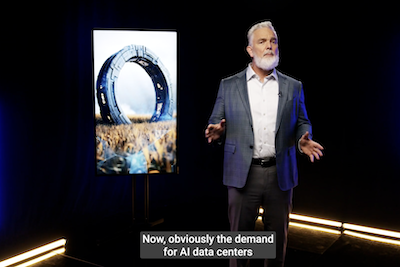Angel Publishing’s Jason Williams has released a presentation about what he’s calling the “Newton Battery,” which he claims is the “future of global energy.”
According to Williams, this battery could “reorganize the energy industry overnight” and mint a new generation of “energy millionaires” in the process.
“The Newton Battery could reorganize the energy industry overnight.
Minting an entire new generation of energy millionaires… and even billionaires.”
What the heck is a “Newton Battery?” What company is Jason Williams spruiking? And is the battery this company makes really the future of global energy storage?
That’s what I wanted to know, so I looked into his claims to see what I could uncover. And in this post, I’ll show you what I found, including the name of the company he’s teasing.
Breaking Down Williams’ “Newton Battery” Pitch
As renewable energy sources like solar and wind continue being built out around the world, one of the biggest problems energy grids face is how to store the energy.
As you know, the sun isn’t always shining, and the wind isn’t always blowing. So if solar and wind are going to power the grid effectively, a proper energy storage solution is essential.
There are numerous options already in place, including lithium-ion batteries, sodium-sulfur batteries, and hydrogen fuel cell energy storage systems.
However, in the presentation, Jason Williams talked about how the materials needed to make today’s energy storage systems, like lithium and cobalt, are expensive. And he pointed out that they have issues such as catching fire and leaking power over time.
“Our typical methods of storing energy are also expensive to produce because they rely on supply-constrained metals like lithium and cobalt.
Their high costs makes these batteries extremely difficult to scale for grid-level power use.
These energy storage methods leak power, too.
They degrade over time. They lose their ability to hold a charge. And become worthless. So they must constantly be replaced.
Plus, they’re dangerous and can literally blow up at a moment’s notice.”
That last part may be a bit hyperbolic (lol) but Williams makes a good point overall about some of the challenges facing current energy storage systems.
And the solution, according to Jason Williams, is the “Newton Battery.” Because he claims it doesn’t have these problems, making it safer, cheaper, and more scalable.
“But lithium batteries… sodium-sulfur batteries… hydrogen fuel cells… none of these will cut it as true grid-scale energy storage systems.
The Newton Battery is the solution that the world has been waiting for…
It’s more cost-effective than other batteries… it’s safer than other batteries… and it can be easily scaled up in size to meet any level of power demand.”
So, what exactly is a Newton Battery?
First and foremost, there’s no such thing as an actual “Newton Battery.” This is just what Jason Williams calls the battery technology his presentation centers around.
And he said he named it the Newton Battery after Sir Isac Newton because, long story short, the battery stores energy using gravity.
“Well, I named it the Newton Battery after the world’s most famous physicist, Sir Isaac Newton.
And that’s because Newton’s major discovery was the natural force that exists between all objects in the universe…
It’s also the same force this battery uses to reliably store and release the massive amounts of energy it takes to consistently power the grid…
I’m talking about gravity.”
What’s this technology (actually) called?
In the presentation, Jason Williams never revealed the (actual) name of the battery technology he was spruiking or the company behind it. But he did share numerous clues and discussed how the energy storage system works.
For instance, he showed several photos of an unusual-looking “crane-like” machine with concrete blocks hanging off it and said that this “battery” can store energy forever.
“And no, this is not a crane…
It’s not an amusement park ride either…
What you’re looking at is the future of global energy.”
[…]
“Because thanks to a huge technology breakthrough, it stores power using common industrial materials like steel and concrete…
Meaning that it’s much cheaper to produce, much easier to scale, and far safer compared with the conventional batteries on the market.
And here’s the best part: Once energy is stored in this battery, it lasts FOREVER.”
How does it work?
The “Newton Battery” (which isn’t its real name) is a large-scale energy storage system deployed near renewable energy projects. And it works using gravity.
In short, when excess power from a solar or wind farm isn’t needed, it’s sent to this machine (which is located nearby) that uses the energy to pick up large blocks, creating a kind of “block tower” in the process.
And later when the power is needed (for instance, at night time when the sun isn’t shining), the blocks are lowered, turning mechanical motors and sending energy back to the grid in the process.
So it uses kinetic energy and gravity to store and release energy.
That’s the gist of how it works, anyway.
In the next section, I’ll show you the company behind this energy storage system and discuss the different projects it’s working on in more detail.
What Company Is Jason Williams Teasing?
As expected, Jason Williams didn’t share the name of the “Newton Battery” company in the presentation, but his clues were enough to help me figure it out.
For instance, he said the company is “trading for around $10 a share,” hinted about its market cap, and talked about some of its current projects and customers.
“This company’s technology is proven.
In fact, this company’s revolutionary storage solution is already a huge success in Switzerland.
It’s currently connected to the Swiss national power grid.
And it’s also being used by Saudi Aramco.”
But what led me to Jason Williams’ pick were the clues he shared about its technology because there’s only one company I could find that’s building the type of energy storage machine he described.
And that company is Energy Vault Holdings (NRGV), a Swiss-based energy storage company that specializes in long-duration gravity and kinetic energy storage systems.
The following video the company released explains how its energy storage system works, which all but confirms that this is Jason Williams’ pick.
Note that this is a promotional-type video, and I’m NOT promoting this company, but it also explains how the machine works, so I thought it was worth sharing.
Is this machine really the “future of global energy,” as Jason Williams suggests?
I’m not an expert on energy storage systems, so I recommend doing your own research on this topic. But from my perspective, the concept itself is pretty cool. As explained, the machine uses gravity and kinetic energy (AKA movement) to store and release energy.
There are some skeptics, though.
For instance, one popular YouTube video claims it’s a “dumb idea” given the C02 needed to make the concrete blocks, the wind factor, and the lack of potential energy storage the system could handle. The video also suggests that the machine is essentially a different version of an existing technology called pumped-storage hydroelectricity.
Those seem like valid points, too. But I always like to look at the other side of an argument because I’ve found that this is often the best way to form an objective opinion. And in this case, there are several potential counterpoints to the “dumb idea” argument.
First, the FAQ page on the company website suggests that Energy Vault can deliver the benefits of a pumped hydro storage system at a “lower levelized cost,” “higher roundtrip efficiency,” and without the need for specific land topography.
Second, the company utilizes materials other than recycled concrete (for example, remunerated coal ash and recycled wind blades) to make the blocks.
And as for the wind factor, the company has released a video about a different “gravity energy storage” system it has designed that could potentially mitigate this. Like the other version of the machine (shown above), this system uses gravity and kinetic energy, so the overall concept is the same. But the blocks are lifted, held, and lowered differently.
What’s my opinion? As mentioned, this isn’t my area of expertise, but I think what this company’s working on is pretty cool, so I’m keen to see what comes out of it.
However, whether or not this technology is the “future of global energy,” as Jason Williams suggested in the presentation, is a different story.
And either way, there’s no guarantee you’ll make money investing in the company. So I suggest taking Jason Williams’ claims about how the “Newton Battery” could mint “energy millionaires” with a grain of salt because nobody knows how any investment will play out.
Nevertheless, there are some recent articles online about Energy Vault and its energy storage systems, so there’s plenty to chomp on if you want to learn more.
For instance, a Seeking Alpha article that breaks down the investment case for Energy Vault refers to it as a “promising but highly risky” idea.
You could also see Jason Williams’ report called “Newton Battery: The New Emperor of Energy Storage,” which reveals the name of the company he’s teasing (which I believe is Energy Vault) and the reasons why he’s bullish.
That said, the only way to access that report is to join an Angel Publishing service called Future Giants, which costs almost $2k.
What Is the “Future Giants” Service?
Future Giants is a new Angel Publishing stock advisory service run by investment guru Jason Williams that focuses on small- and micro-cap companies.
“The companies I target will be small or even microcap companies. They’ll span multiple sectors and industries, but they’ll all have one thing in common…
The potential to be a massive company that dominates its industry in the near future.
Just like this tiny company behind the Newton Battery that could conquer the global $546 billion market for energy storage.
With Future Giants, you’ll be given recommendations that are often so small and so unique that I can only recommend them to a small number of savvy opportunists.
I look for companies with “market caps” as small as $10 million or $20 million that could soar to $50 million, $100 million, or more within a few short months or years.”
The way it works is similar to most stock advisories I come across in that, as a subscriber, you get access to research and recommendations on different companies. And from there, you can decide which ideas you want to follow and which ones to avoid.
The main difference with this service is that it’s focused on smaller, more speculative companies. And at $1,999, it’s more expensive than his flagship service, The Wealth Advisory, which I’ve written about before.
As a side note, I’ve also written about other investment ideas Jason Williams has teased recently, like this post about his “Robot Royalties” pitch. So if you want to see what other companies he’s tracking, you may find that worth a read.
In any case, to sum it up, subscribers of Future Giants get weekly investment write-ups, access to a model portfolio, updates, research reports, and monthly videos.
Is it worth it?
I’m not a member of Future Giants, so I can’t say for sure. But what I can say is that, as with any service, there’s no guarantee you’ll make money following Williams’ stock picks.
Bottom Line
Jason Williams’ “Newton Battery” presentation centers around an energy storage system that uses gravity and kinetic energy to store potential energy from wind and solar projects, and the clues he shared lead me to believe he’s teasing Energy Vault Holdings.
Assuming my guess is correct, I have no idea if what this company’s working on will be the future of global energy storage or not, but it was interesting to look into, if nothing else.
What do you think? Is the “Newton Battery” presentation just hype? Or could a gravity-based energy storage system really solve the world’s energy storage problems? Let me know in the comments section below. Thanks for reading!





Thanks for the info. I will invest a small $ amount just to see what comes of this.
The Swiss are on to something, only over produced elect. to store the energy is using free energy.
We have had 2 hydro dams in the UK for years where the water is pumped back up to the reservoir during the night and released during the day or during high demand. Why do still only have 2. In both Scotland and Wales its always raining so no shortage of free energy.
Perhaps it’s the PC brigade undermining the loss of natural vistas.
Right on something for nothing.
Very well written review of Jason Williams pitch of the “Newton Battery”, and well worth the read!
These tease investment adds are, in my view, extremely expensive, and pull on the heart strings of all investors who would like to hit it “big”.
Again, non-biased review with no sales pitch. Thanks.
My pleasure, glad it helped and thanks for the comment.
You can store energy by using a pressurized system, think of it as a very strong steal tank with very high air pressed in it and ready to be used by a controlled valve?
You do not have to build towers with heavy blocks of steel hanging in air!
Of course, the extra energy that can not be stored now because of the battery issues, will be used to pressurize the tank and recaptured like the energy in a battery. By the way the blocks in Newton Battery also uses energy for raising them.
I am an engineer and that is only one idea? Let me know what you think.
Yeah, I think the general concept of the “newton battery” could be applied in numerous different ways. As for what would be superior, I have no idea as I am not an engineer or expert on that sort of thing. I just wanted to know what the stock was. 🙂 Thanks for chiming in.
What’s the company?
I believe the company Williams is teasing is Energy Vault Holdings.
NEWTON BATTERY and “pumped storage hydroelectricity”
I love these ideas!
However nothing can beat the Laws of Conservation of Energy and Matter.
You just can’t get something for nothing.
Multiple moving parts give rise to power losses.